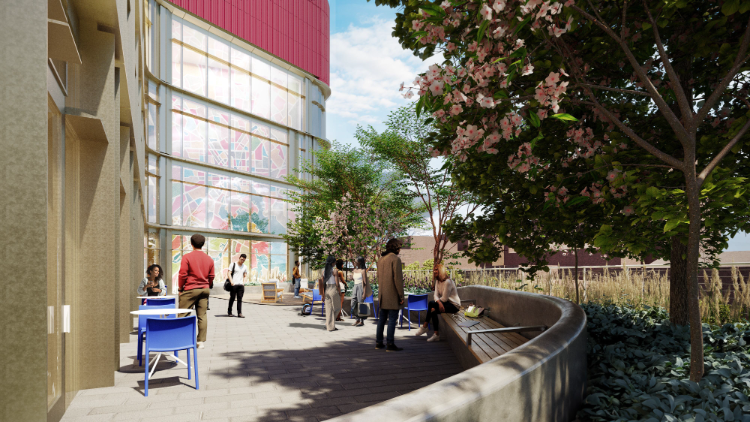High Performance Building Envelope
The high-performance envelope consists of highly insulated, airtight wall assemblies with triple glazed windows. These features will lower the heating load by 12% (300 kBtu) and the cooling load by 4% (20 tons). Learn more about the importance of building envelopes in energy performance here.
Geothermal Exchange Wells
42 geothermal exchange wells will support heat pumps that provide 1,855 kBtu of heating capacity and 135 tons of cooling capacity.
How does geothermal work? The bore field is a closed loop of pipes below the new building filled with a water solution. During the winter, the air is cooler than below the ground. The water solution circulates in a loop underground and absorbs the Earth's heat. The heat is brought to the surface and transferred to a heat pump in the building. The heat pump warms the air, and ducts circulate the air to various rooms.
In the summer, the system works in reverse. The ground is cooler than the air. The solution circulates in a loop under ground and it's cooled by the ground's lower temperature. The cooled air is brought to the surface and transferred to a heat pump in the building.
Learn more about how geo-exchange works here.
Electric Heat Pumps
Electric heat pumps will work hand-in-hand with the geo-exchange borefield wells to transfer heat where it is needed (from the building to the ground during the summer, and from the ground to the building during the winter). These heat pumps are more efficient than traditional air source heat pumps that extract heat from outside air to heat buildings. Learn more about different types of heat pumps here.
Solar Photovoltaic Installation
The building's rooftop solar photovoltaic array will produce 112 Kilovolt-amps (approximately 15% of the annual need) on site. Solar panels operate by converting sunlight into electrical energy through semiconducting materials. Learn more about photovoltaic technologies here.
Together, the solar photovoltaic array, geothermal exchange wells, and electric heat pumps provide a decarbonized energy system for the building, helping the university comply with the legislative requirements laid out in Maryland's Climate Solutions Now Act of 2022 and Building Energy Performance Standards.
Natural Stormwater Retention Areas
These areas are intentionally landscaped to assist with rainwater management on the site. In an urban environment like Downtown Baltimore with a high prevalence of hard surfaces, it is important to create stormwater retention areas to help water from rain and snow events to soak into the ground naturally. Learn more about the importance of stormwater management here.
Usable Outdoor Roof Garden
In addition to the ecological benefits that the outdoor roof garden will bring, including attracting pollinators, the space supports the findings of UMB's 2022 Facilities Master Plan Update, in which the campus community emphasized a need for additional parks and green spaces. The new School of Social Work roof garden will provide an area where students, staff, and faculty can work or simply find respite in nature, which can be difficult to find in a dense urban area.



